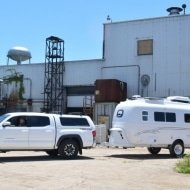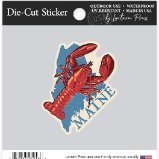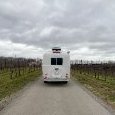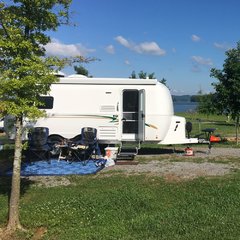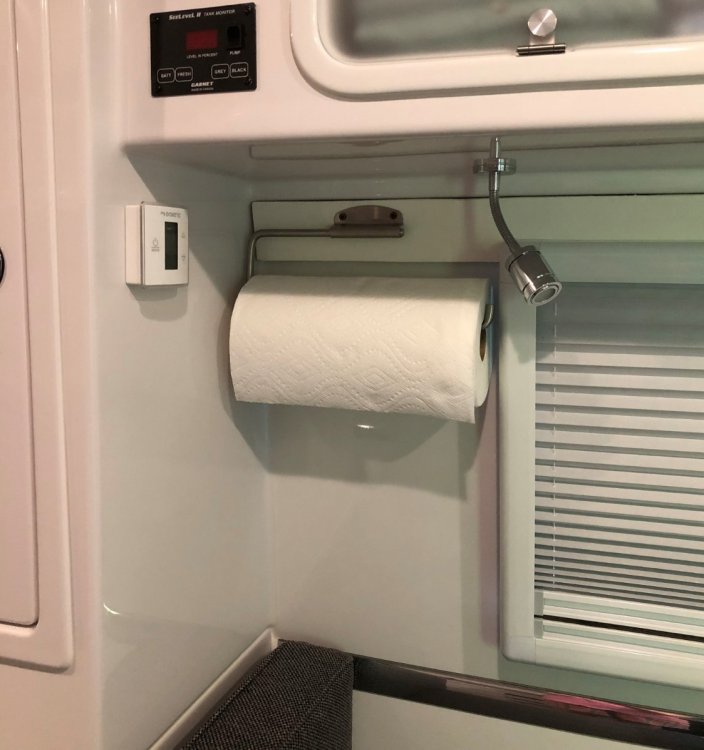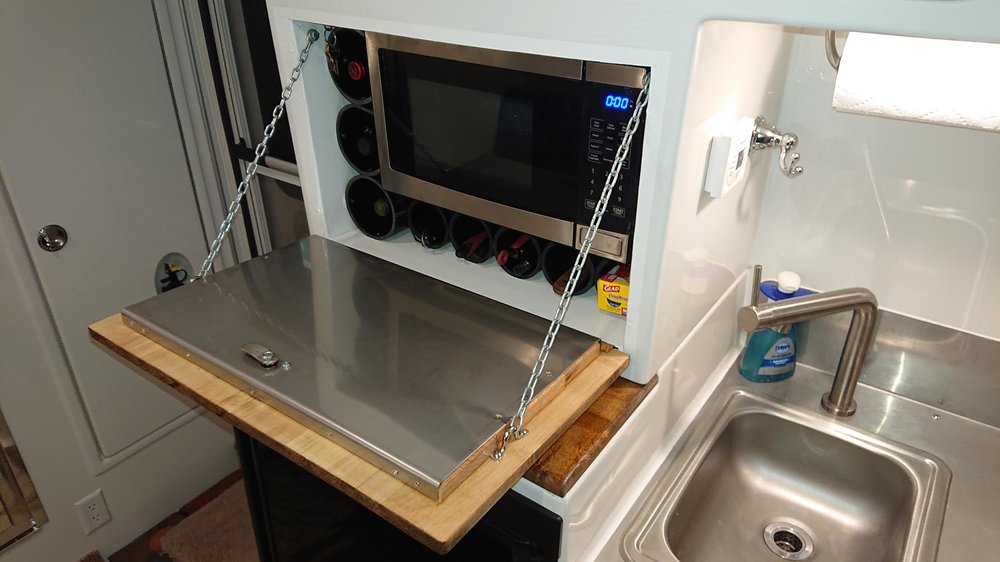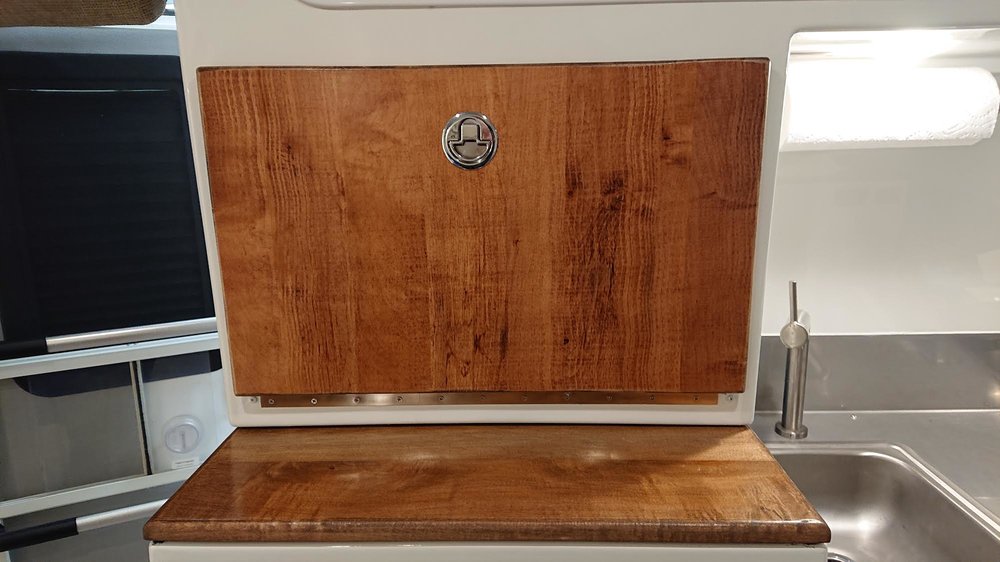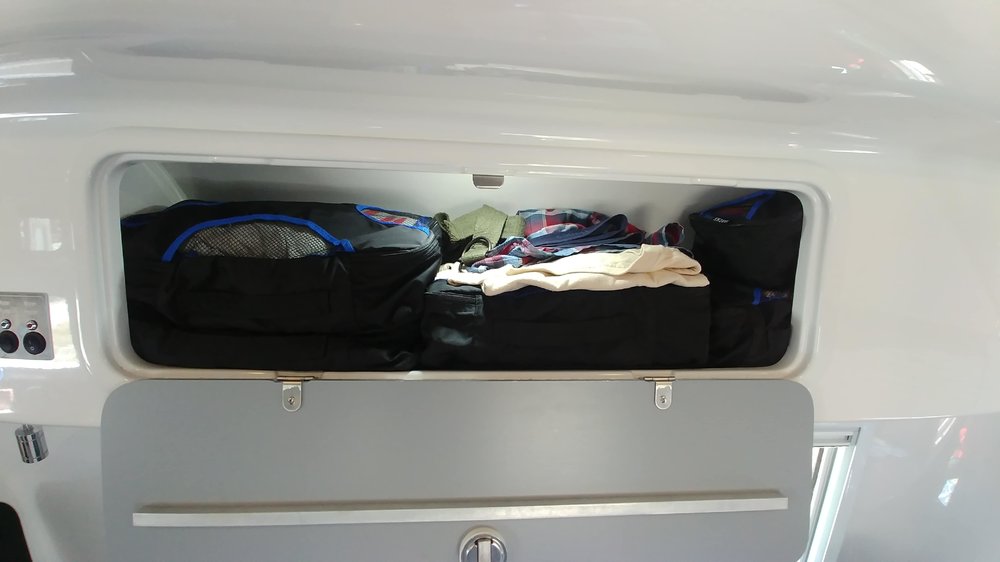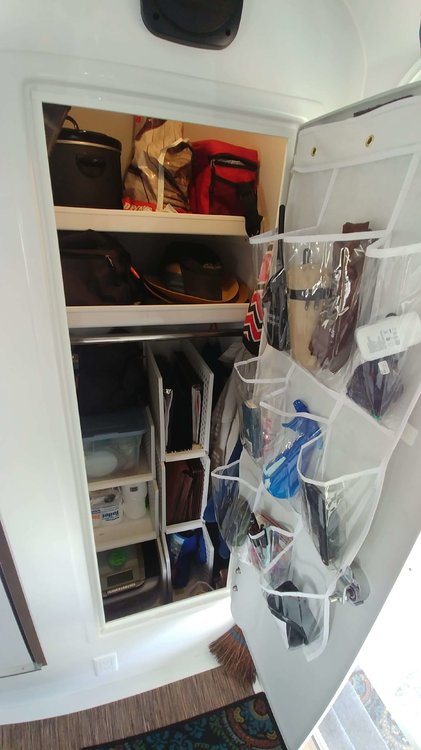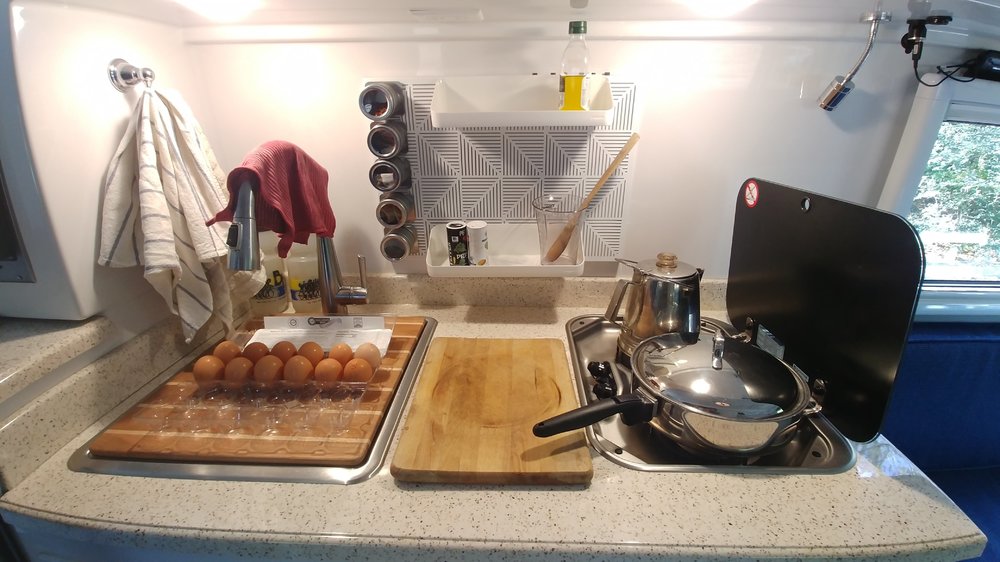Leaderboard
Popular Content
Showing content with the highest reputation on 03/16/2022 in all areas
-
6 points
-
As you compare AGM to Lithium prices, consider how long you are likely to be using the trailer and if you believe "many years" is likely, then it's worth factoring in the comparative predicted lifespans of the two battery types. Lithium doesn't look quite as expensive once you do that, and if you boondock a lot especially with unreliable solar conditions then the Lithium also offers potentially significant additional benefits5 points
-
I didn't order Lithium with my trailer and have just returned from 2.5 months in the SW, some campgrounds with hookups but the majority was either campgrounds where dry camping was available or boondocking. The solar, 2000 watt inverter and 6V AGMs performed flawlessly. I had enough power each night to run the furnace from bedtime to awakening, run electriconics and have lights. I would not have benefitted from the Lithiums mostly because I don't use a electric coffee-maker, hairdryer, microwave, crockpot or waffle iron. For my use, the standard solar and 6V battery bank is more than I need. Now, if Lithium prices came down considerably by the time I am ready to replace my AGMs would I splurge? Maybe, maybe not since a lot of my camping happens during Winter months and in the cold and Lithium just doesn't perform to its full potential in the cold. I understand why many upgrade to Lithium and it makes sense for their camping patterns.5 points
-
We're going with the factory lithiums and solar. Our previous RVs all had small flooded batteries and we carried a generator. I was always stressing about conserving power when boondocking and then taking time to run the generator in the morning and evening. Never again. As for the pricing, I'll be honest, the factory lithiums are a luxury. Yes, we could retrofit an Oliver with lithiums ourselves for less money. But this will be our last RV and we decided to just go for it so we can start enjoying it on day one. We're treating ourselves with this trailer.5 points
-
We got AGM’s because that was what was available back then. They did fine when we boondocked. If lithiums weren’t available I would have replaced them with AGM’s and we would still be happy campers. But, since it looks like we’ll be camping a while longer I thought it was worth it to spend the extra money on lithium batteries. No regrets. Mike4 points
-
4 points
-
I'll second what Mountainman198 said above. I purchased a used, year-old 2020 LEII and it has the solar package/4 AGM batteries/2000W inverter. All of our camping was boondocking last year in places like Rocky MT Nat Park, Custer SP, Canyonlands and forest service campgrounds with no hookups. The 4 AGMs connected to solar always had plenty of power for our needs. Now, we don't have any need to use the A/C where we camp. We had no problem running the heater all night on several trips. We watched downloaded netflix shows on the TV at night. I ran a small coffee maker in the morning and a toaster. My wife ran a 750watt hair dryer. No problem. Now, we were always in the sun where the solar would recharge nicely. I suppose I might have trouble if I were camped in the shade - I don't know. I think the lithium system is surely teriffic but I don't feel I "need" it for what we do and where we camp.4 points
-
Haha, this is not factory camping ground, though I wish the factory camping ground could be this good. I hires painted cowboy to deliver the trailer to Seattle. I think I am OK handling good weather, but not so confident on a 2400 mile trip with unpredictable weather.4 points
-
We really enjoyed the rail trip across Canada from Toronto to Vancouver via VIA and the Rocky Mountaineer. The food and camaraderie were wonderful not to mention the scenery. Saskatchewan was immense and like another planet . I want to go back with the Oliver. Cheers3 points
-
I completely agree. However, this is also a reason to consider adding portable solar panels. A longer cord allows you to position your panels for better sun exposure. Also, many of the new panels perform better on cloudy days. Bluetti's PV120 or PV200 are both great examples. Plus they are light, easy to move around, and easy to store. Of course, you will also need to add a solar charge controller, but by adding a Victron MPPT charger controller, your panels will perform even better on cloudy days.3 points
-
Perhaps they were concerned about the possibility of snow crossing the Rockies. A legit consideration, especially with a new-to-you trailer.3 points
-
The cable passes behind the spare cover and just comes out through the top. It works well as a backup camera as long as you go slow and steady. I still like to get out and check things if I don't have a spotter. The big benefit is not having to have another screen in the vehicle. Not sure what trim level you have but my truck also came with TPMS sensors for the trailer that link right to the trucks infotainment screen which also make for one less device. John, There is no disconnect on the camera but there is plenty of spare cable to set the cover aside. John3 points
-
Years ago, we like took the ferry from Bar Harbor Maine to Nova Scotia. It saves a lot of time and then you can visit Nova Scotia from south to north. We are planning a trip this summer using the ferry and after going through Nova Scotia going to Prince Edward Islands and then south through New Brunswick or going west and come south through Quebec. We use and like RVParky for trip planning2 points
-
I can turn the charger on/off independently of the other electrical things. I just flip the breaker for the charger in the fuse panel under the dinette. All the other 110 stuff stays on. Mike2 points
-
Good point. Here in the Northeast some of our boondocking is in heavy shade. The lithium package will allow us to go longer before needing to move to sun or run a generator. With the larger lithiums we should be able to camp at least a week in the shade, then recharge when we get home again. The limiting factor will now be tank sizes.2 points
-
2 points
-
We did the Canadian VIA trip one year, from Prince Rupert to Jasper. It was beautiful! I hope you have a great time on the Mountaineer.2 points
-
I just finished getting the Solar panels put together and attached to the bed cover. Panels are attached together with 1/8 inch aluminum angle and 304 stainless bolts. After much research I decided to just build some mounts out of aluminum. Every time I got on the 8020 site I ended up with a 500-600 dollar rack and this is really the only thing that will travel on the bed cover. I bought an SOK 100 AH battery that will be fed by these panels to run my ICECO fridge/freezer in the truck bed. The battery has bluetooth and a built in heater and is very well made. $630 direct from SOK. The panels are 100 watt 9BB panels from BougeRV. Testing them in the driveway here south of Atlanta I was getting some pretty impressive yields. They are wired in series and feed a Victron 100/30 MPPT SCC. I am going to connect the panels to the charge controller through some Anderson Powerpole connectors. By doing this it will be easy to disconnect from the victron in the truck and connect these to soon to be installed victron MPPT in the Oliver. Since they are run in series and put out plenty of voltage and I can park the truck in the sun and not need a large gauge wire on the run to the trailer. John2 points
-
The Lithionics OTT uses are heated. Battle Born offers heated batteries, but you have to specify you want those. I believe the Battle Born will last longer, according to their data. I considered getting Battle Born for our trailer. However, even with removing the slide out drawer, you cannot get as many amp hour in that space as you get with the two 315 Lithionics for a total of 630 amp hours. The way batteries are advancing, if I ever need to replace the Lithionic, I am sure there will be better options at a later date. Kirk2 points
-
We are from Mississauga Ontario Canada and have camped from coast to coast in Canada. Our style of camping usually involves Provincial or National parks and on an adhoc basis. So far (forty years) it has worked out. We could help out a little with our thoughts on route selection based on our experience. Your trip sounds amazing! Please feel comfortable reaching out.2 points
-
I'm interested to install the GM rear accessory camera that connects to 20-22 GM trucks with trailering camera package/camera accessory port near the hitch. I've read the manual online and I understand the mounting position for correct "invisible trailer" view is at the top of the spare tire cover. I know there are at least a few Oliver owners with this set-up. Can you please share how you mounted the rear camera? I'd rather not drill holes in the trailer or the spare cover if possible. I'm considering the 3M automotive tape and feel this would be sufficient, especially if the mounting bracket is on the top surface of the spare tire cover. I'm planning to run the connecting wire on the underside of the trailer along the propane line on the streetside. Anyone have any experience, advice or photos to share? Thanks in advance!1 point
-
As we patiently wait for our March delivery, I noticed that the 2022 Owner's and Component Manuals are now available in Oliver University. I have downloaded and used Adobe to link the Table of Contents to the document to avoid scrolling. Hope some find this useful, I intend to do this with the component manuals as well. Please let me know if you discover any errors. Cheers, Pat 1276727297_2022-OTT-Owners-Manual-11-04-2021-linkedTOC.pdf1 point
-
So.... be sure to use them down to that level, I guess? I will be storing but I'm in the tropics, practically speaking. I am planning to cover my Oliver with that Calmark cover, because finding covered storage space is difficult and expensive.1 point
-
I have a 1956 German Rheinmetall typewriter with a sheet of paper in it where I type things that I want to bring to Hohenwald. It's a big job figuring out what to bring. Probably someone has already made such a list. I realize that everyone's list will be different, but there are probably a high percentage that everyone brings. Do you know of any list like that? I hate to invent the wheel again if someone has already come up with the wheel. What can I say?! I have a lazy side.1 point
-
Now that more campgrounds are charging for electrical use by the amp/hour on top the the regular site fee, this is interesting, You can turn the charger off while connected to shore power? The campground would be really surprised to see no amp/hours used!1 point
-
Shiny and new! I remember that excitement and joy. I also remember that sense of trepidation with systems that were new to me and not wanting to "wreck" anything on my new "baby". The excitement of planning trips with this new thing and then the enjoyment of actually going on those trips. The promise of many years of travel together. Hopefully all of these things came with your Ollie. ENJOY! Bill p.s. that sure is one strange antenna on the roof of your Ollie!😄1 point
-
My solution back from my trucking days was simple, i set my CB antenna (mounted to my mirror bracket) to about 2 inches taller than my trailer and adjusted the height whenever I changed trailers. I'd slow down and if the antenna hit then I knew I had less then 2 inches clearance (or possibly none!). I hadn't thought about it recently, but it wouldn't be difficult to mount some type of "measuring stick" to the truck to accomplish the same thing. That said, I've not seen many overpasses or tunnels that are less than 10 feet so my backup plan has always been to open the driver's door, with the vehicle in gear and my foot hovering over the brake, I stand in the open doorway while watching the top of the trailer and if it looks like it's going to hit I jam on the break (which in the old days resulted in stalling the truck but sparing an accident). Even if it has enough clearance if you hit a bump in the tunnel or under the bridge, it could cause the trailer to jump high enough to crunch the roof so it's always better to creep through those places slowly and like you said, it generally results in testing "sphinter control."1 point
-
I'm gonna mount the battery and solar controller in a milk crate or something similar. It will be secured in the truck bed when in use. Panels and battery will be removed when we are not out camping. Wires will just be run under the side of the cover. I don't want anymore holes in the top. John1 point
-
@Jps190 That looks great! I really like the ability to open the DB cover with the panel attached. Looks like 600 watts could squeeze on pretty easily…1 point
-
I used the 8020 extrusions and brackets (purchased from McMaster Carr) for my home built bike rack on my truck bed cover. The cross rail for the rear tires has quick release mounts so that rail can be quickly removed to flip the bed cover open when needed. 8020 is great stuff for hardware projects. Next tweak to the system is to add a couple mounts to carry our portable waste tote tank in between the two bikes.1 point
-
I can't give you specific advice as my LE II is a 2020 and when I ordered mine, Oliver did not offer any lithium options (they announced availability three weeks after I ordered mine). After purchase, I immediately upgraded to Lithium. The upgrade was painless . Having said that, I would probably order the full Oliver lithium package if I had it to do over again just for convenience and the bells and whistles of Oliver's battery choice. As a point of reference though, I will explain my experience in which I easily upgraded later. Since Oliver had no lithium option and I planned to convert to lithium right away, I asked Oliver to add the solar system and inverter, but I would stick with the standard 2 flooded batteries when I ordered. Oliver said I had to upgrade to 4 batteries (flooded were fine) if I ordered the solar/inverter system because they needed 4 batteries to test out the whole system before delivery. So I upgraded to from 2 to 4 flooded batteries. When I got the trailer home, I replaced the four flooded batteries with 4 Lion Energy UT 1300 lithium batteries through Costco (113 ah each for a total of about 450 ah). They were $700 each (Costco has specials on these batteries a couple times a year) The UT 1300 lithiums (only 23 lbs each) are group 24 size which is the same footprint as the four flooded batteries (Group 27) that came in the Oliver. That made it easy. All I did was remove the four flooded batteries and replaced them with the 4 lithiums. They were an exact fit and I didn't have to change out any of the wiring. Truly plug and play. It took about 2 hours. It would have taken half that time except that the posts on the UT 1300 lithiums were both sized the same as a negative terminal on a flooded battery so I had to run to NAPA and buy a replacement negative terminal for my positive battery cable so it would fully tighten onto the postive post of the first lithium battery. (The positive terminal post on the flooded batteries is slightly larger than the negative terminal post I learned.) That was not an issue with the remaining three batteries because the cables attach to screw posts with wing nuts.) I now have 18 months of experience with my lithium batteries and at least 12 boondocking trips. No problems whatsoever, knock on wood. The UT 1300 lithiums don't have bluetooth or heaters but that hasn't been a problem. Each battery has a button you push that will light up a row of 5 LED's when the batteries are above 70% state of charge (SOC), when you get down to only 2 led lights lit, the battery is down to about 20% state of charge. While crude and not particularly accurate, they work and I always have a good idea of how much juice I have left. The Battery Management system (BMS) in the UT 1300 seems to work fine, and has all the important safety systems built in (e.g., won't charge if the battery is below freezing, etc.). I store my trailer outside and the solar system keeps the batteries fully charged all the time in the summer. In the winter, I am connected continuously to shore power which makes sure the batteries are brought to a full charge each day. I know this is not recommended for maximum battery life, but the Lion Energy warranty is 8 year replacement with no pro-ration if the batteries drop to less than 70 percent capacity in the first 8 years. We'll see.1 point
-
Maybe you should mention those apps, because we don’t know which threads you are referring to….. John Davies Spokane WA1 point
-
I'd bet that most of us have not used both. Therefore a direct comparison has not been done. So, as they say, you place your bets and see what happens.🤔 Bill1 point
-
After two and a half years of ownership and being a retired Body Shop Mgr. I decided it was time to buff the trailer. My trailer sets outside because my wife said if I wanted a cover it would have to be the $20,000 cedar wood type and not a metal cover type. So I decided I could buff it every couple of years and that is what I do, just did it 3 months ago and it turned out beautiful, and I do good work if I don't say. I used products for fiberglass buffing and I did post it here on the forum, it's somewhere. I prefer the buffing process as it does takeoff the oxidation of the Gel Coat and cover it up. trainman1 point
-
John, thank you! This is exactly the kind of info I'm looking for. I'm assuming that Oliver installed the camera bracket by drilling holes and did they drill another hole for the cable or does this pass behind the spare cover? Are you happy with the camera system? Does it function well as a back-up assist view? (I'm actually more interested in the back-up assist view than I am in the "invisible trailer" view) Thanks again, Dan1 point
-
1 point
-
"They are stored in a cool, dry place in my home" Are they on a trickle charge to maintain them at 100%. I thought they had to cycle through a discharge/charge cycle. I have SO MUCH to learn about these batteries!1 point
-
We don’t have the lithium batteries. We have the old fashioned lead acid wet cell batteries (and no solar). During winter storage I plug the trailer into our household AC about once every two weeks or so to keep the batteries charged. For our method of getting the cover on, I lay the cover out on the ground on the curbside of the trailer, and I tie a rope through one of the grommets around the bottom of the cover, then toss the rope over the top of the trailer to the street side, and then with one person pulling on the rope on the street side, and one person on a ladder on the curbside, it’s just a matter of getting the cover up over the awning housing and up onto the roof of the trailer. Once the cover is up on the roof it’s easy to work it down around the sides of the trailer.1 point
-
1 point
-
A compressor fridge like my medium ARB unit works great, but it uses around 60 amp hours daily, and it also provides continual “amp anxiety”. With marginal solar when the days are short or grey, it makes me constantly worry about recharging the batteries. I am much happier and laid back if I just leave the fridge at home. If I had a larger solar array, I would be more likely to bring it along. It operates off the alternator when moving, and off the trailer batteries when stopped. I hate the older three way fridge for a number of reasons, but I do have to admit it works well enough and doesn’t drain the batteries if you tow with it set to propane. I would rather use those truck amps to recharge the trailer batteries than operate the fridge….. it is a very heavy draw when set to 12 volts. John Davies Spokane WA1 point
-
1 - yes. If your intent is to run the fridge/freezer on 12 volt while driving down the road then it would be prudent to plan to NOT open the door of the fridge thereby preventing cold air from escaping. My ice-cream stays hard! 2 - Maybe. This depends on how much food and/or use you plan to give the existing fridge. I'd plan on not getting a separate unit until you actually see what your usage is. Congrats on the April pickup! Hopefully we'll have a chance to meet at the Rally in May if you plan on being there. Bill1 point
-
Thanks, For all your comments. The thread I was referring to was the one John reminded me that I should have added with several pictures of a worn out Anderson 2" ball. My feeling is with the 2023 $8,500 base price increase the 2022 (which we have on order) the price difference was small in the scheme of things. Also, my apologies if I offended anyone. This is my first camper and a learning experience. As I tell my friends I can fly airplanes (I have an Airline Transport Pilot rating) but have never towed a trailer. This is going to be an adventure in and of itself. Dale1 point
-
Wow, I never had a list for trailer camping and setup, it just all seemed to work together and with a little commonsense it always seemed to work out well. For those who feel uncomfortable and are first timers that you might consider setting up and taking down the trailer at home, maybe you will have to go through the process 2-3 times and all will start to fall in place for you. For me it's a three step process, 1. find your camping site, check it out by observation and then pull in, level and unhitch from tow vehicle, 2. hookup all the utilities and check each operation for correct operation, 3. setup chairs, tables, grill, and everything else that you will need for your camping pleasure. I would say this should take no more then 30-45 minutes to do, unless you stop and talk with other campers which can be distraction at times. My wife does the inside setup and I do the outside, but inside usually goes quick, so she will also help outside with chairs, lights, etc. Do remember it's not a race to see how fast you can do it, you don't get prizes for being first. I would say here that teardown takes longer, mainly because I clean and re-roll all lines and return them to there storage area for use again. Last remember that not all camping sites are perfect and you will find yourself making repairs at the electrical and water hookup faucet connections, yes bad and worn out leaking faucets are common, being a electrician and plumber are required for your camping success at times, so carry tools you will need them for something, for sure. trainman1 point
-
Agreed, I bought two of those before I took delivery of my Elite 2, based on a video I watched onTechnoRV.com. They seem to work fine. You just have to remember to give the active tank a few pumps after you turn the valve on. https://www.technorv.com/gasstop1 point
-
I'm hoping that someone with the Lithium package will chime in on the feasibility of running the fridge on 12V while in transit. When we had our old travel trailer, I'd put a small bag of dry ice in the fridge just before departure, then turn the fridge off. Only if we were planning to be on the road for more than 90 minutes, or if it was unusually hot. Otherwise I would just pack the fridge with some frozen items and/or a few ice packs, and hit the road.1 point
-
The auto function fridges in the newer trailers operate differently from our older Dometic units. They will select from all three available power sources, be careful it at it doesn’t select DC. Ninety per cent of all RVers run their fridges on propane while traveling. We driven >150K miles like this and I don’t ever recall a situation where we were required to turn it off.1 point
-
Thanks guys! I forgot to check back & this is how we installed the paper towel holder. John cut a 2 3/4" wide x 22" long x 3/4" thick board. He round it on the back corners so it would slide between the window facing and curve in the wall of the Oliver wall above the window. He painted it white. In our 2021 it is across from the kitchen sink in the dining nook. Best part about this installation is it's easily removable as there is no tape, screws, etc as the board simply slides in the space.1 point
-
Welcome. Not a long time to wait. Hope the weather is good for your delivery. You asked about chocks. I like the heavy rubber chocks from Harbor Freight, if you have a store nearby. Often on sale at 5.99, with the 20 per cent off coupon, 5 bucks. I'm thinking about the things we take each year, or buy, when we deliver new rvs. Throw rugs. An inside and outside walkoff mats. 2 x 6 cutoffs for leveling. A melitta type pourover cone to make coffee without electricity. A fry pan, a saucepan, a couple good knives, cutting board, aluminum foil and a few plastic bags. A few bits of plates, knives, forks, kitchen utensils, including corkscrew and can opener. A small trash can. Trash bags. A small broom and dust pan. Scrubbies and scrub brush. A notebook, and pens that work. Bedding, including pillows. And a nice warm duvet or quilt. Towels . Meds and hygiene items. A small tool kit, including duct tape, a multitip screwdriver, small socket set. A hatchet. Utility knife. A couple folding chairs to sit outside. Credit cards. Good Sam's roadside insurance card. A couple flashlights . Batteries. Inline water filter. Not a lot of stuff. Maybe take a small electric cube heater, since it's February, depending on your direction of travel, and if you'll have hookups. I'd probably carry a gallon of rv antifreeze, just in case, which you should be able to buy in Hohenwald. But, something I like to keep around in shoulder season. Specifically for the Oliver, a collar lock for the bulldog hitch. Tire pressure monitor system if you have a bit of a distance, or add it ar home . The longer we travel, the less extra stuff I carry. Honestly. The rest I can buy along the way, if we actually need it. We picked up in February 2008. It wasn't warm, but it wasn't freezing cold, either. Driving back to Tampa, via the panhandle, we didn't need a lot. We'll look forward to your photos. Don't overpack, and enjoy the ride. Sherry1 point
-
1 point
-
We've been full timing in our Oliver since Nov of 2017. Here are some pics of storage solutions that work for us. It took a while living in the Ollie to really determine how we would use the space so I would caution you to give yourself some time. [attachment file=0311191047.jpg] [attachment file=163145] [attachment file=163148]1 point
-
Recent Achievements









